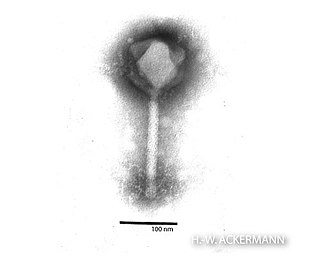
Podoviridae is a family of bacteriophage in the order Caudovirales often associated with T-7 like phages. There are 130 species in this family, assigned to 3 subfamilies and 52 genera. This family is characterized by having very short, noncontractile tails. Podoviradae are largely understudied and most new isolates are of the phicbkviruses genus, a group of giant viruses that appear to be Caulobacter specific.

Caudovirales is an order of viruses known as the tailed bacteriophages. Under the Baltimore classification scheme, the Caudovirales are group I viruses as they have double stranded DNA (dsDNA) genomes, which can be anywhere from 18,000 base pairs to 500,000 base pairs in length. The virus particles have a distinct shape; each virion has an icosahedral head that contains the viral genome, and is attached to a flexible tail by a connector protein. The order encompasses a wide range of viruses, many containing genes of similar nucleotide sequence and function. However, some tailed bacteriophage genomes can vary quite significantly in nucleotide sequence, even among the same genus. Due to their characteristic structure and possession of potentially homologous genes, it is believed these bacteriophages possess a common origin.

Tectiviridae is a family of viruses with 10 species in five genera. Bacteria serve as natural hosts. Tectiviruses have no head-tail structure, but are capable of producing tail-like tubes of ~ 60×10 nm upon adsorption or after chloroform treatment. The name is derived from Latin tectus.
Enquatrovirus is a genus of bacteriophages in the order Caudovirales, in the family Podoviridae. Bacteria serve as natural hosts. There is currently only one species in this genus: the type species Escherichia virus N4.
Peduovirus is a genus of viruses in the order Caudovirales, in the family Myoviridae, in the subfamily Peduovirinae. Bacteria serve as natural hosts, with transmission achieved through passive diffusion. There are 15 species in this genus.
Twortvirus is a genus of viruses in the order Caudovirales, in the family Herelleviridae, in the subfamily Twortvirinae. Bacteria serve as natural hosts. There is only one species in this genus: Staphylococcus virus Twort.

Schizotequatrovirus is a genus of viruses in the order Caudovirales, in the family Myoviridae, in the subfamily Tevenvirinae. Bacteria serve as natural hosts. There are three species in this genus.
Pbunavirus is a genus of viruses in the order Caudovirales, in the family Myoviridae. Bacteria serve as natural hosts. There are 27 species in this genus.
Myohalovirus is a genus of viruses in the order Caudovirales, in the family Myoviridae. Bacteria and archaea serve as natural hosts. There are three species in this genus.

Phikzvirus is a genus of viruses in the order Caudovirales, in the family Myoviridae. Bacteria serve as natural hosts. There are three species in this genus.
Salasvirus is a genus of viruses in the order Caudovirales, in the family Salasmaviridae, in the subfamily Picovirinae. Bacteria serve as natural hosts. There are four species in this genus.
Ceduovirus is a genus of viruses in the family Siphoviridae, unassigned to a sub-family. Bacteria serve as the natural host, with transmission achieved through passive diffusion. There are 34 species in this genus.
Fromanvirus is a genus of viruses in the order Caudovirales, in the family Siphoviridae. Bacteria serve as natural hosts, with transmission achieved through passive diffusion. There are 59 species in this genus.
Lambdavirus is a genus of viruses in the order Caudovirales, in the family Siphoviridae. Bacteria serve as natural hosts, with transmission achieved through passive diffusion. There are five species in this genus. The genus also includes several unclassified viruses—including the corynephages β and ω, which infect Corynebacterium diphtheriae and carry the deadly diphtheria toxin.
Ravinvirus is a genus of viruses in the order Caudovirales, in the family Siphoviridae. Bacteria serve as natural hosts, with transmission achieved through passive diffusion. There is only one species in this genus: Escherichia virus N15.
Lomovskayavirus is a genus of viruses in the order Caudovirales, in the family Siphoviridae. Bacteria serve as natural hosts. There are two species in this genus.
Psimunavirus is a genus of viruses in the family Siphoviridae. Bacteria and archaea serve as the natural host, with transmission achieved through passive diffusion. There is only one species in this genus: Psimunavirus psiM2.
Spbetavirus is a genus of viruses in the order Caudovirales, in the family Siphoviridae. Bacteria serve as natural hosts. There is only one species in this genus: Bacillus virus SPbeta.
Tequintavirus is a genus of viruses in the order Caudovirales, in the family Demerecviridae. Bacteria serve as the natural host, with transmission achieved through passive diffusion. There are currently 22 species in this genus, including the type species Escherichia virus T5.
Tunavirus is a genus of viruses in the order Caudovirales, in the family Drexlerviridae. Bacteria serve as natural hosts. There are currently 14 species in this genus, including the type species Escherichia virus T1.




